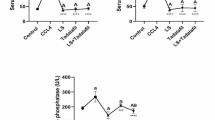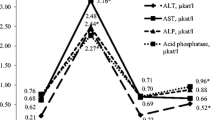Summary
When heat-killedPropionibacterium acnes was intravenously injected into mice followed by an intravenous injection of a small amount of Gram-negative lipopolysaccharide seven days later, most of the mice died of massive hepatic cell necrosis within 24 hours. However, when irsoglandine maleate, an antiulcer agent, was administered to mice during the period of experimental induction of acute hepatic failure, the survival rate, serum transaminase levels and histological changes of the liver remarkably improved. These results suggested that irsoglandine maleate may have protective effects on the liver in our experimentally-induced acute hepatic failure model using mice. Therefore, in the absence of a definitive therapy for fulminant hepatitis, irsoglandine maleate may be a promising therapeutic agent.
Similar content being viewed by others
References
Tsutsui H, Mizoguchi Y, Yamamoto S, et al: Studies on experimentally-induced acute hepatic failure: Possible involvement of activated liver adherent cells. In: Kirn A, Knook DL, Wisse E, eds. Cells of the Hepatic Sinusoid, vol 1. The Kupffcr Cell Foundation, The Netherlands. 1986:307–314
Tsutsui H, Mizoguchi Y, Miyajima K, et al: Studies on an experimentally-induced acute hepatic failure in mice. Jpn J Gastroenterol 1986;83:1324–1329 (in Japanese)
Mizoguchi Y, Tsutsui H, Sakagami Y, et al: Characteristics of the hepatocytotoxic factor in mice with experimentally-induced massive hepatic cell necrosis. Jpn J Allergol 1988;37:959–968
Ueda F, Aratani S, Mimura K, et al: Effect of 2,4-diamino-6- (2,5-dichlorophenyl)-s-triazine maleate (MN-1695) on gastric ulcers and gastric secretion in experimental animals. Arzneim-Forsch 1984;34:474–477
Okabe S, Takeuchi K, Ishihara Y, et al: Effects of [2,4-diamino-6-(2,5-dichlorophenyl)-s-triazine maleate] (MN-1695) on gastric secretion and on experimental gastric ulcers in rats. Pharmacometrics 1982;24:683–689(in Japanese)
Ucda F, Hara K, Mimura K, et al: General pharmacology of 2,4-diamino-6-(2,5-dichlorophenyl)-s-triazine maleate (MN-1695). (3) Effects on the blood coagulation and electrolyte metabolism, and miscellaneous effects. Pharmacometrics 1986; 32:849–860 (in Japanese)
Ueda F, Aratani S, Mimura K, et al: Effect of 2,4-diamino-6- (2,5-dichlorophenyl)-s-triazine maleate (MN-1695) on gastric mucosal damage induced by various nccrotizing agents in rats. Arzneim-Forsch 1984;34:478–484
Ueda F, Watanabe M, Hirata Y, et al: Mechanism for the antiulcer action of 2,4-diamino-6-(2,5-dichlorophenyl)-s-triazine maleate (MN-1695). Pharmacometrics 1987;33:157–163 (in Japanes)
Ueda F, Aratani S, Mimura K, et al: Effect of 2,4-diamino-6- (2,5-dichlorophenyl)-s-triazine maleate (MN-1695) on gastric mucosal blood flow in dogs. Arzneim-Forsch 1984;34:485–491
Ueda F, Yano T, Kimura K, et al: Gastric cytoprotection by 2,4-diamino-6-(2,5-dichlorophenyl)-s-triazine maleate (MN-1695). In: International Committee of Japanese Society of Gastroenterology, eds. New Trends in Peptic Ulcer and Chronic Hepatitis (Part I). Excerpta Medica Found, Amsterdam 1987;364-370
Mizoguchi Y, Tsutsui H, Miyajima K, et al: The protective effects of prostaglandin E1 in an experimental massive hepatic cell necrosis model. Hepatology 1987;7:1184–1188
Mizoguchi Y, Sakagami Y, Seki S, et al: Protective effects of a leukotriene inhibitor in an experimental massive hepatic cell necrosis model. Gastroenterol Jpn 1988;23:263–267
Ohkura Y, Mizoguchi Y, Sakagami Y, et al: Inhibitory effect of TJN-101 ((+)-(6S,7S,R-Biar)-5,6,7,8-tetrahydro-1,2,3,12-tetramethoxy-6,7-dimethyl-10,11-methylenedioxy-6,dibenzo [a,c] cyclooctenol) on immunologically-induced liver injuries. Jpn J Pharmacol 1987;44:179–185
Mizoguchi Y, Kodama C, Arakawa T, et al: Effects of prostaglandin in an experimentally-induced acute hepatic failure model. Jpn J Gastroenterol 1987;84:2558–2562 (in Japanese)
Abecassis M, Falk R, Blendis L, et al: Treatment of fulminant hepatic failure with a continuous infusion of Prostin VR (PGE1). Hepatology 1987;7:110
Loewenstein WR: Junctional intercellular communication: The cell-to-cell membrane channel. Physiol Rev 1981;61:829–913
Kyoi T, Mimura K, Ueda F, et al: Intercellular communication of cultured rabbit gastric epithelial cells. Jpn J Pharmacol 1989;49(Suppl):192
Author information
Authors and Affiliations
Rights and permissions
About this article
Cite this article
Mizoguchi, Y., Kawada, N., Ichikawa, Y. et al. Effects of irsoglandine maleate in an experimentally-induced acute hepatic failure model using mice. Gastroenterol Jpn 26, 177–181 (1991). https://doi.org/10.1007/BF02811077
Received:
Accepted:
Issue Date:
DOI: https://doi.org/10.1007/BF02811077




